The AMD A10-7700K and AMD A6-7400K CPU Mini-Review
by Ian Cutress on May 27, 2015 9:00 AM ESTOffice Performance
The dynamics of CPU Turbo modes, both Intel and AMD, can cause concern during environments with a variable threaded workload. There is also an added issue of the motherboard remaining consistent, depending on how the motherboard manufacturer wants to add in their own boosting technologies over the ones that Intel would prefer they used. In order to remain consistent, we implement an OS-level unique high performance mode on all the CPUs we test which should override any motherboard manufacturer performance mode.
All of our benchmark results can also be found in our benchmark engine, Bench.
Dolphin Benchmark: link
Many emulators are often bound by single thread CPU performance, and general reports tended to suggest that Haswell provided a significant boost to emulator performance. This benchmark runs a Wii program that raytraces a complex 3D scene inside the Dolphin Wii emulator. Performance on this benchmark is a good proxy of the speed of Dolphin CPU emulation, which is an intensive single core task using most aspects of a CPU. Results are given in minutes, where the Wii itself scores 17.53 minutes.
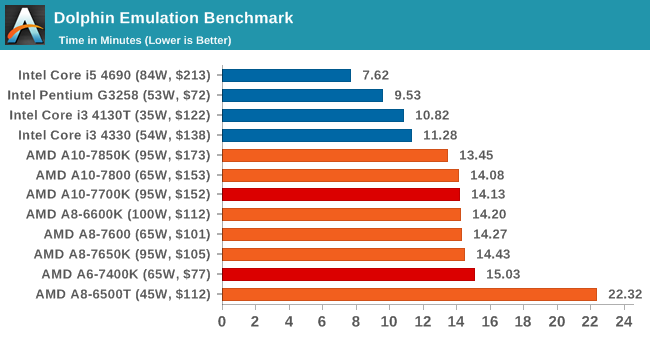
WinRAR 5.0.1: link
Our WinRAR test from 2013 is updated to the latest version of WinRAR at the start of 2014. We compress a set of 2867 files across 320 folders totaling 1.52 GB in size – 95% of these files are small typical website files, and the rest (90% of the size) are small 30 second 720p videos.
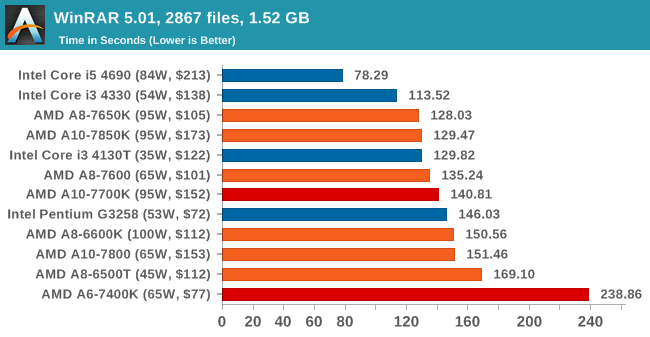
The single module of the 7400K shows the deficit in a slightly threaded workload.
Image Manipulation – FastStone Image Viewer 4.9: link
Similarly to WinRAR, the FastStone test us updated to the latest version. FastStone is the program I use to perform quick or bulk actions on images, such as resizing, adjusting for color and cropping. In our test we take a series of 170 images in various sizes and formats and convert them all into 640x480 .gif files, maintaining the aspect ratio. FastStone does not use multithreading for this test, and thus single threaded performance is often the winner.
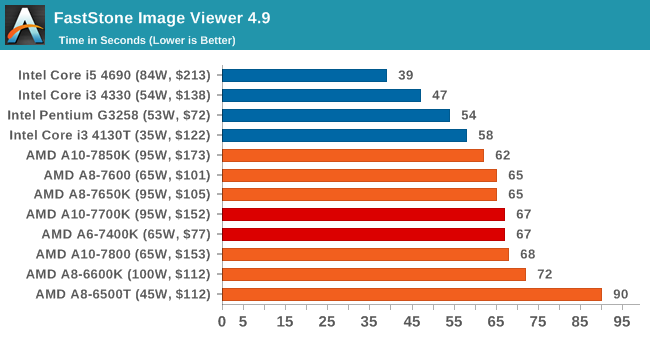
For a purely single threaded test, both of the AMD APUs performed similarly here.
Web Benchmarks
On the lower end processors, general usability is a big factor of experience, especially as we move into the HTML5 era of web browsing. For our web benchmarks, we take well known tests with Chrome 35 as a consistent browser.
Mozilla Kraken 1.1
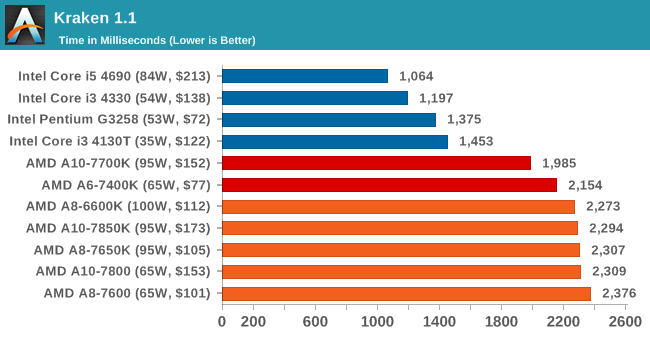
Google Octane v2

Professional Performance: Windows
We have a few benchmarks to characterise professional level performance on Windows.
Agisoft Photoscan – 2D to 3D Image Manipulation: link
Agisoft Photoscan creates 3D models from 2D images, a process which is very computationally expensive. The algorithm is split into four distinct phases, and different phases of the model reconstruction require either fast memory, fast IPC, more cores, or even OpenCL compute devices to hand. Agisoft supplied us with a special version of the software to script the process, where we take 50 images of a stately home and convert it into a medium quality model. This benchmark typically takes around 15-20 minutes on a high end PC on the CPU alone, with GPUs reducing the time.
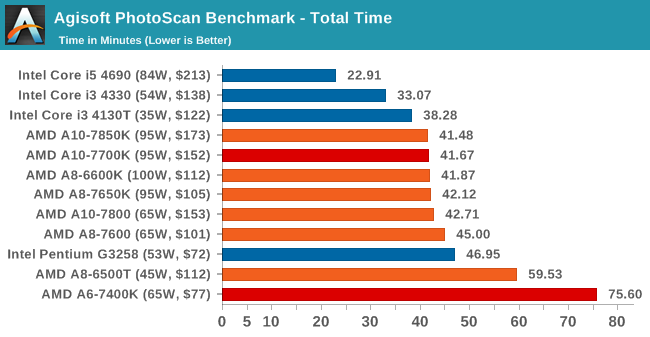
Cinebench R15
Cinebench is a benchmark based around Cinema 4D, and is fairly well known among enthusiasts for stressing the CPU for a provided workload. Results are given as a score, where higher is better.
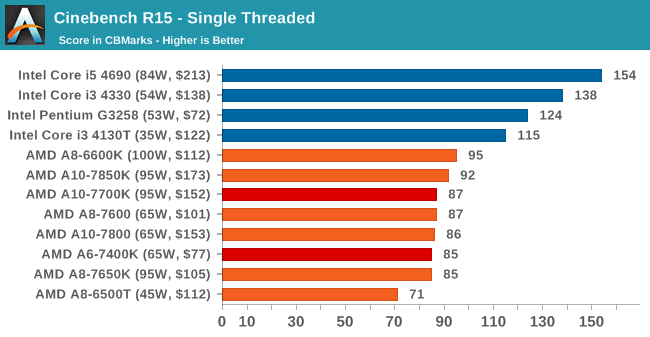

Linux Performance
Built around several freely available benchmarks for Linux, Linux-Bench is a project spearheaded by Patrick at ServeTheHome to streamline about a dozen of these tests in a single neat package run via a set of three commands using an Ubuntu 11.04 LiveCD. These tests include fluid dynamics used by NASA, ray-tracing, OpenSSL, molecular modeling, and a scalable data structure server for web deployments. We run Linux-Bench and have chosen to report a select few of the tests that rely on CPU and DRAM speed.
C-Ray: link
C-Ray is a simple ray-tracing program that focuses almost exclusively on processor performance rather than DRAM access. The test in Linux-Bench renders a heavy complex scene offering a large scalable scenario.
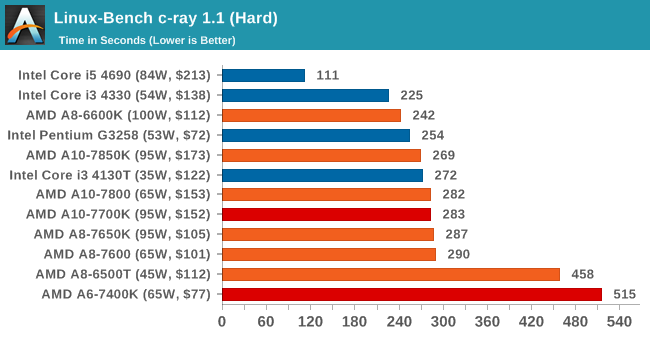
NAMD, Scalable Molecular Dynamics: link
Developed by the Theoretical and Computational Biophysics Group at the University of Illinois at Urbana-Champaign, NAMD is a set of parallel molecular dynamics codes for extreme parallelization up to and beyond 200,000 cores. The reference paper detailing NAMD has over 4000 citations, and our testing runs a small simulation where the calculation steps per unit time is the output vector.
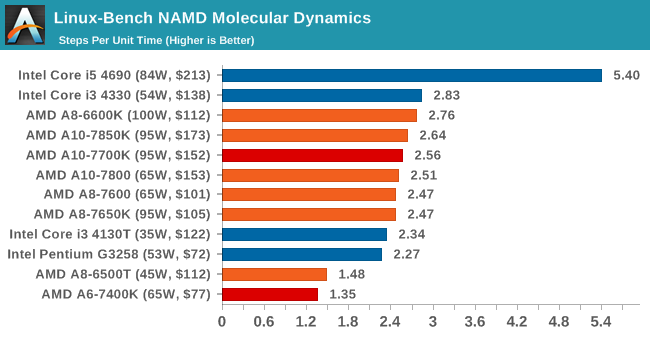
NPB, Fluid Dynamics: link
Aside from LINPACK, there are many other ways to benchmark supercomputers in terms of how effective they are for various types of mathematical processes. The NAS Parallel Benchmarks (NPB) are a set of small programs originally designed for NASA to test their supercomputers in terms of fluid dynamics simulations, useful for airflow reactions and design.











105 Comments
View All Comments
leexgx - Thursday, May 28, 2015 - link
they need to update CPU-z to correctly show that the Modular CPU on the new cpus of AMDor at least show core as modules as they are effectively a single core CPU or dual core performance wise, AMD currently does not have a Quad core CPU in the current line up (Quad Module)
akamateau - Thursday, May 28, 2015 - link
I can't disagree with your assessmant of AMD marketing. It is non-existant. But what is worse is when wirters such as Ian Cutress LIE to their readers.These new AMD releases ALL are meant for Windows 10 and DX12. Where are the DX12 benchmarks?
Cutress has 3dMark API Overhead and Starswarm yet he benches new products with an OBSOLETE API: DX11.
Why doesnlt he bench them using DX12?
As a wrieter Cutress is obkiged to write about ALL of the facts not just those that he wants the consumer to know or those facts that Intel pays him to cover-up.
So Cutress what;s it going to be? Are you GUTLESS or do you have the STONES to show us the DX12 benchmarks?
jospoortvliet - Thursday, May 28, 2015 - link
These APU's are only useful for playing old games - DirectX 11, thus. Those fancy, non-existent DirectX 12 games will most likely be too heavy for it anyway. Heck, he should test DirectX 9 games, rather than DX 11...UtilityMax - Friday, May 29, 2015 - link
And guess what, as you can see from the benchmarks, the iGPU from the A10 line does not make almost any difference over the iGPU from the A8 line. On paper, A10 has 1/3 mode GPU processing units, but in reality both are starved for memory bandwidth, so it makes almost no difference if you use A10 or A8 GPU. Looking at all the benchmarks, the A8-7600 is the most solid choice among the Kaveri parts. It loses almost nothing to the A10 line in terms of performance, while costing less and burning less power.ES_Revenge - Saturday, May 30, 2015 - link
Keep in mind there *are* i5s that are dual-core--essentially i3s with turbo. Clarkdale i5s (i5-6xx) are all that way, and ALL laptop/mobile i5s are dual-core + HT + turbo. I'm not saying the 7700K should have the A10 name (it shouldn't, I agree) but it's not like Intel doesn't have exceptions to their branding as well.Shadowmaster625 - Wednesday, May 27, 2015 - link
That A8-7650K is a really nice part. The 7700k seems rather redundant.xenol - Wednesday, May 27, 2015 - link
I can't wait for a Zen based APU with HBM. I'm yawning at seeing Bulldozer derivatives.r3loaded - Wednesday, May 27, 2015 - link
Yep, especially when a $72 Intel CPU matches or beats all of AMD's offerings in everything except iGPU gaming and heavily multithreaded workloads.Edens_Remorse - Wednesday, May 27, 2015 - link
You are mistaken if you think the G3258 beats the 860k in gaming when discrete graphics are involved.nandnandnand - Wednesday, May 27, 2015 - link
Anything pre-Zen from AMD is a waste of space at this point.